
A visual deconstruction of
David Bowie’s Space Oddity
David Bowie’s Space Oddity

––––––––––––––––––
WHY SPACE ODDITY
David Bowie left us with a constellation of intersecting worlds, loaded with material for celebration, consideration and interpretation.
Space Oddity was the launching pad for David Bowie’s ascension to mainstream notoriety.
In arguably one of the most acclaimed tracks of a distinguished career, we are introduced to Major Tom — an astronaut, launched into space, who leaves his rocket and drifts into the void, never to return.
The song is rich in cultural connections and presents an appealing combination of songwriting, theatre, and storytelling — a wealth of visual inspiration to draw on from a very interesting period in popular culture.

1969 UK release


––––––
ABOUT
The project visualises data from Bowie's 1969 track Space Oddity on a series of 10 specially engraved records with accompanying posters, plus a moving image piece.
Each12-inch disc deconstructs the track in a different way: melodies, harmonies, lyrics, structure, story and other aspects of the music are transformed into new visual systems.
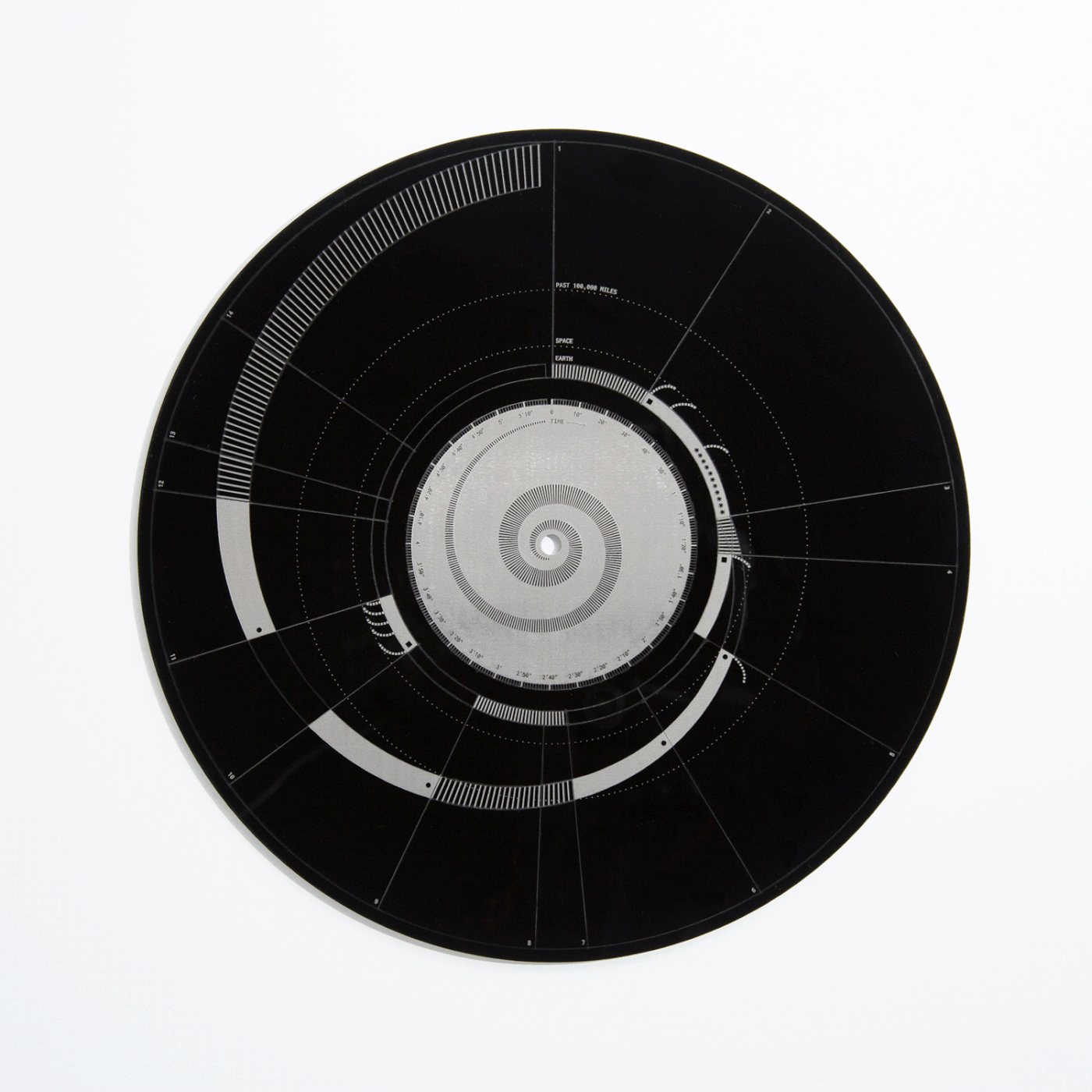
Engraved discs
Moving image

–––––––––
PROCESS
Data
We based our research on the 2009 remaster of the album version of Space Oddity, simply because it was the version we liked the most. Miriam gathered most of the data by ear by listening to the song carefully, many times over. This manual data-gathering method allowed us to explore our own interpretation of the song.

Sketches
Post-analysis, we needed a system that would both allow comparison of the song’s dimensions and the communication of our interpretation. The vinyl record offered the perfect medium. From Edison’s phonograph to today’s vinyl records, music has been encoded through a series of grooves that spiral to the centre of the circular disc.
You can read more about the process on my article on Medium.



Design
Each visualisation is laser-engraved into a 12-inch acrylic disc. One rotation of the record equals the duration of the song, five minutes 17 seconds.


The core of the project is a series of 10 specially engraved records. Each 12-inch disc deconstructs the track in a different way: melodies, harmonies, lyrics, structure, story and other aspects of the music and lyrics are transformed into new visual systems. A poster accompanies each record, containing an image of the engraving plus a key.











The first of the records in the series illustrates our interpretation of the story of Space Oddity. It is a story with two characters: Ground Control and the doomed astronaut, Major Tom.
First, Ground Control barks orders at Major Tom as he is blasted off into the cosmos. Once in orbit, he’s a celebrity but Major Tom sings back to Ground Control in more fatalistic terms: ‘Planet Earth is blue and there’s nothing I can do’. At some point, the signal goes dead. We leave Major Tom floating round his tin can, far above the Moon.



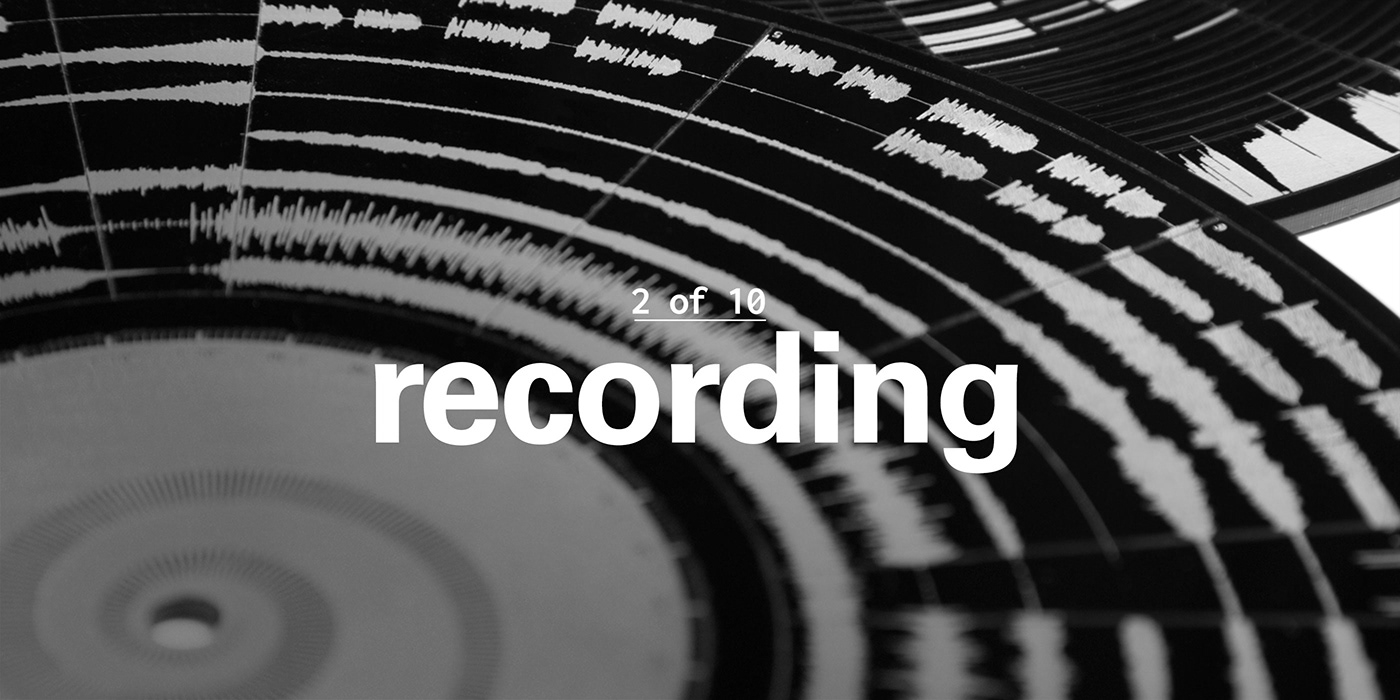
The second record in the Oddityviz series deconstructs Bowie’s Space Oddity into its eight original master tracks, released in 2009 as part of a special edition marking the song’s 40th anniversary.
We visualised the master tracks in a very simple way, as waveforms. These make up the circular bands on the record – wider for louder sounds, narrower for quieter.



Texture visualises which voices or instruments can be heard in each bar of the song. A symbol means there is vocals or instruments in that bar; no symbol means it’s silent. Three vocal parts tell the story of Space Oddity — a main vocal and two backing vocals — accompanied by seven instruments and a string section.
Paul Buckmaster’s string section plays for the first time during the tense liftoff section, then adds a kind of introspective spaciousness to Major Tom’s rather sad chorus (‘For here am I sitting in a tin can / Far above the world’) and to the guitar solo. The strings become increasingly chaotic in the outro, where the players start sliding up and down the fingerboard. Space Oddity features several other unusual instruments. Now-vintage analogue synthesisers give the track a 1960s touch: a cranky old Mellotron huffs into life, paired with an out-of-tune Stylophone.
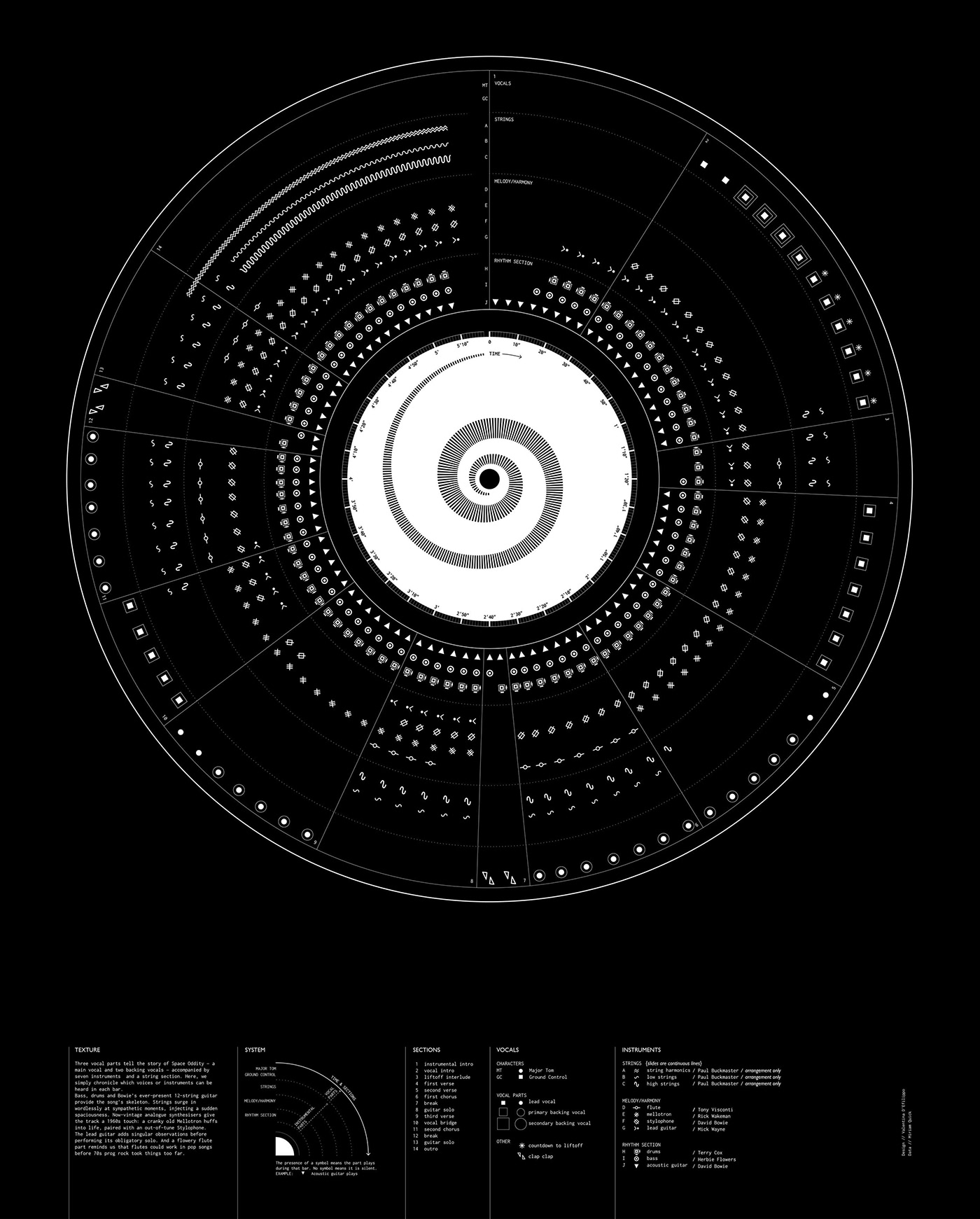


The fourth record in the series deconstructs the bass guitar and drum parts of Space Oddity. These instruments, together with the rhythm guitar, make up the rhythm section in a band. The bass and drum parts were recorded together onto master track (available on the Space Oddity 40th Anniversary EP), which is well worth listening to by itself.
This record visualises every bass note and drum hit played by these excellent musicians in Space Oddity. The data for this record took the longest to gather out of all the records. By our reckoning, there are 528 individual bass picks in the song and 943 drum hits – counting instances where two drums are struck simultaneously as one hit. We counted them all!



This record shows the chord progressions in Space Oddity. The y-axis of the record represents the chord root note, running from C on the outside to the B nearest the middle.
Major chords are represented by thick lines and minor chords by thin lines. Seventh chords are shown by rings added to the chord: one ring for a flattened or lowered seventh, and two rings for a raised seventh (as in F major 7).



The sixth record in the Oddityviz series visualises the structure of Bowie's vocal line, showing repetition on the phrase and section level. Repeated phrases are linked by arcs and repeated sections are shown around the middle of the record.
Solid lines link vocal phrases that are repeated exactly, while dotted lines link sections that are recognisably repetitions of one another, but with a slight change the second or third time. We distinguish lyrical from musical or melodic repetition. An example of a repeated melody would be: ‘You’ve really made the grade’, ‘I’m stepping through the door’ and ‘I’m feeling very still’, which are all sung to the same tune. An example of a modified melodic repeat would be: ‘And I’m floating in a most peculiar way’ versus ‘And the stars look very different today’ – the beginning of the tune is the same, the ending is different.



Oddityviz record number seven, like number six, deconstructs Bowie's vocal line. But this time it's all about the notes in the melody. The vocal part of Space Oddity contrasts sections of near-monotone, revolving around one or two repeated notes, with more lyrical, wide-ranging melodies.
The song was written to be a duet. But, in the end, Bowie performed both characters and through melody he is interpreting each role. Ground Control’s low, almost monotone pitch is contrasted by high pitch and wide-ranging melodies for Major Tom. Here, groups of lines show which pitches occur in each melodic phrase, with higher notes towards the middle of the record. The record also displays the waveform of the lead vocal track. Where Bowie's voice sings as Ground Control, the waveform comes out from the middle of the record and where he sings as Major Tom, the waveform comes in from the outside.
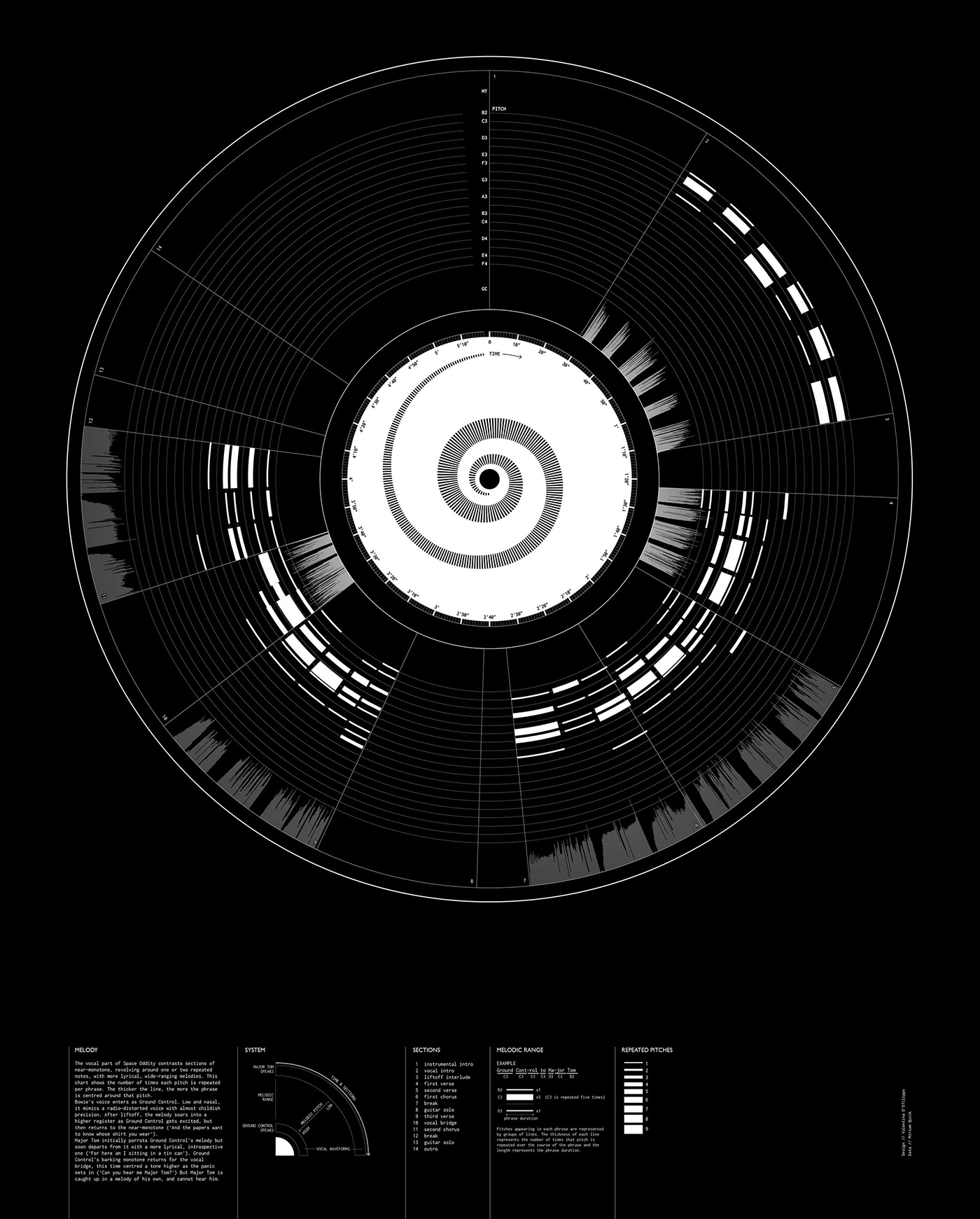


Space Oddity is an intricate story whose often-simple lyrics belie a complex musical structure. Here we illustrate the grammatical structure of the lyrics as a series of trees. Each line of the song forms a single tree.
The branches represent the structural relationships between words and symbols on the ends of the branches indicate word type.The base of each tree covers the line duration and its anchoring point denotes which of four categories of utterance the line falls into – transmission, description, command or action / feeling. The lines are then coded by the character in the song who sings them – a square for Ground Control and a circle for Major Tom.



This record stands out from the rest due to its use of a distinct visual language: emoji. Rather than being driven by data, it utilises illustration and iconography that loosely represent text and incorporates visual metaphors from Kubrick’s 2001 Space Odyssey — one of the main inspirations.
In 1977, the two Voyager space probes were launched. On board both craft are golden records, engraved with audio and illustrations depicting life on Earth. This visual language was developed for the benefit of any alien life forms who might come across them. When making this, the ninth disc in the Oddityviz series, we asked ourselves: how can we tell the story of Major Tom so it could be understood by an alien? While the other records contain data visualisation, this is more of an infographic. That is, rather than being driven by data, it’s driven by illustration and images that loosely code for text.


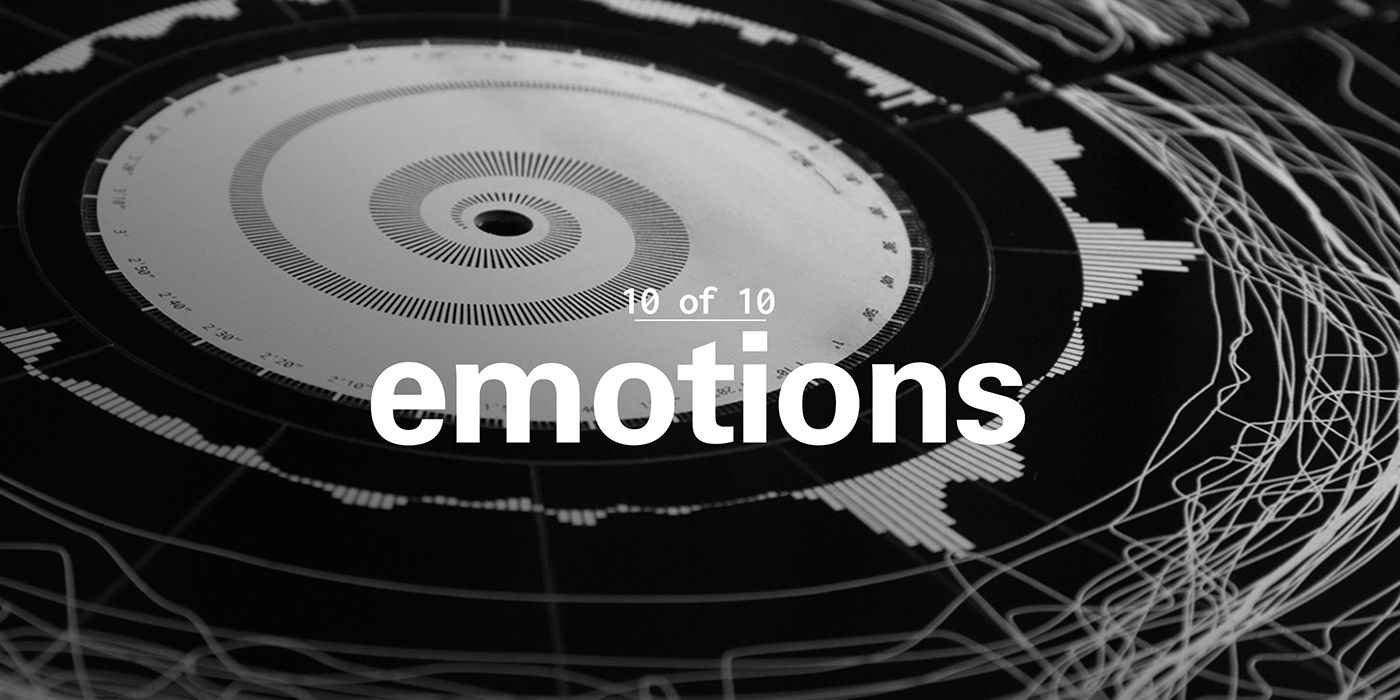
Music moves us, creating a kaleidoscope of emotions that shifts with the sound. The tenth and final Oddityviz record shows a set of emotional responses to the song from listeners. We asked our friends to draw a line corresponding to the level of emotion they felt while listening to Bowie’s Space Oddity, then plotted the results on the record.
'Emotion’ is admittedly a strange metric. What is emotion? You can deconstruct it endlessly. It could relate to many musical elements – dynamics, harmony, lyrics and so on. And the experience of it is unique to each person. We deliberately simplified the issue by treating emotion as a single variable running from low to high. Would the results still make sense?





Visit our shop to buy high-quality art prints. Each print features an exact copy of the original record, plus a key. If you wish to buy an engraved record please send us an email: oddityviz@gmail.com





CREDITS
Valentina D’Efilippo / Desig
valentinadefilippo.co.uk
@defilippovale
Miriam Quick / Data
miriamquick.com
@miriamquick
valentinadefilippo.co.uk
@defilippovale
Miriam Quick / Data
miriamquick.com
@miriamquick
Mike Brondbjerg / Generative and data animation
Genevieve Sheppard / Production
Ben Hutton / Photography
Mike Naman / Window installation
Elliott Kajdan / Motion image advice
Timothy Sondreal / Installation support
A massive thank you to our funders at W+K London for their generous support.
Wieden+Kennedy London / wklondon.com / @W2Optimism
Genevieve Sheppard / Production
Ben Hutton / Photography
Mike Naman / Window installation
Elliott Kajdan / Motion image advice
Timothy Sondreal / Installation support
A massive thank you to our funders at W+K London for their generous support.
Wieden+Kennedy London / wklondon.com / @W2Optimism

















